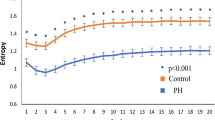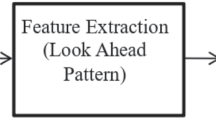Abstract
A detection–theoretic approach to quantify heart rate turbulence (HRT) following a ventricular premature beat is proposed and validated using an extended integral pulse frequency modulation (IPFM) model which accounts for HRT. The modulating signal of the extended IPFM model is projected into a three-dimensional subspace spanned by the Karhunen–Loève basis functions, characterizing HRT shape. The presence or absence of HRT is decided by means of a likelihood ratio test, the Neyman–Pearson detector, resulting in a quadratic detection statistic. Using a labeled dataset built from different interbeat interval series, detection performance is assessed and found to outperform the two widely used indices: turbulence onset (TO) and turbulence slope (TS). The ability of the proposed method to predict the risk of cardiac death is evaluated in a population of patients (n = 90) with ischemic cardiomyopathy and mild-to-moderate congestive heart failure. While both TS and the novel HRT index differ significantly in survivors and cardiac death patients, mortality analysis shows that the latter index exhibits much stronger association with risk of cardiac death (hazard ratio = 2.8, CI = 1.32–5.97, p = 0.008). It is also shown that the model-based shape indices, but not TO and TS, remain predictive of cardiac death in our population when computed from 4-h instead of 24-h ambulatory ECGs.








Similar content being viewed by others
References
Barthel, P., R. Schneider, A. Bauer, K. Ulm, C. Schmitt, A. Schömig, and G. Schmidt. Risk stratification after acute myocardial infarction by heart rate turbulence. Circulation 108(10):1221–1226, 2003. doi:10.1161/01.CIR.0000088783.34082.89.
Bauer, A., M. Malik, P. Barthel, R. Schneider, M. A. Watanabe, A. J. Camm, A. Schömig, and G. Schmidt. Turbulence dynamics: an independent predictor of late mortality after acute myocardial infarction. Int. J. Cardiol. 107(1):42–47, 2006. doi:10.1016/j.ijcard.2005.02.037.
Bauer, A., M. Malik, G. Schmidt, P. Barthel, H. Bonnemeier, I. Cygankiewicz, P. Guzik, F. Lombardi, A. Mnller, A. Oto, R. Schneider, M. Watanabe, D. Wichterle, and W. Zareba. Heart rate turbulence: standards of measurement, physiological interpretation, and clinical use: International Society for Holter and Noninvasive Electrophysiology consensus. J. Am. Coll. Cardiol. 52(17):1353–1365, 2008. doi:10.1016/j.jacc.2008.07.041.
Cygankiewicz, I., W. Zareba, R. Vazquez, M. Vallverdú, J. R. Gonzalez-Juanatey, M. Valdes, J. Almendral, J. Cinca, P. Caminal, A. Bayés de Luna, and M. S. Insuficiencia Cardiaca Investigators. Heart rate turbulence predicts all-cause mortality and sudden death in congestive heart failure patients. Heart Rhythm 5(8):1095–1102, 2008. doi: 10.1016/j.hrthm.2008.04.017
Exner, D. V., K. M. Kavanagh, M. P. Slawnych, L. B. Mitchell, D. Ramadan, S. G. Aggarwal, C. Noullett, A. V. Schaik, R. T. Mitchell, M. A. Shibata, S. Gulamhussein, J. McMeekin, W. Tymchak, G. Schnell, A. M. Gillis, R. S. Sheldon, G. H. Fick, H. J. Duff, and Investigators, R.E.F.I.N.E. Noninvasive risk assessment early after a myocardial infarction the REFINE study. J. Am. Coll. Cardiol. 50(24):2275–2284, 2007.
Ghuran, A., F. Reid, M. T. L. Rovere, G. Schmidt, J. T. Bigger, A. J. Camm, P. J. Schwartz, M. Malik, and Investigators, A.T.R.A.M.I. Heart rate turbulence-based predictors of fatal and nonfatal cardiac arrest (the autonomic tone and reflexes after myocardial infarction substudy). Am. J. Cardiol. 89(2):184–190, 2002.
Hallstrom, A. P., P. K. Stein, R. Schneider, M. Hodges, G. Schmidt, and K. Ulm. Structural relationships between measures based on heart beat intervals: potential for improved risk assessment. IEEE Trans. Biomed. Eng. 51(8):1414–1420, 2004. doi:10.1109/TBME.2004.828049
Jager, F., A. Taddei, G. B. Moody, M. Emdin, G. Antolic, R. Dorn, A. Smrdel, C. Marchesi, and R. G. Mark. Long-term ST database: a reference for the development and evaluation of automated ischaemia detectors and for the study of the dynamics of myocardial ischaemia. Med. Biol. Eng. Comput. 41(2):172–183, 2003.
Kay, S. M.: Fundamentals of Statistical Signal Processing. Detection theory. Upper Saddle River: Prentice Hall, 1993.
Lin, L. Y., L. P. Lai, J. L. Lin, C. C. Du, W. Y. Shau, H. L. Chan, Y. Z. Tseng, and S. K. S. Huang. Tight mechanism correlation between heart rate turbulence and baroreflex sensitivity: sequential autonomic blockade analysis. J. Cardiovasc. Electrophysiol. 13(5):427–431, 2002.
Marine, J. E., M. A. Watanabe, T. W. Smith, and K. M. Monahan. Effect of atropine on heart rate turbulence. Am. J. Cardiol. 89(6):767–769, 2002.
Mäkikallio, T. H., P. Barthel, R. Schneider, A. Bauer, J. M. Tapanainen, M. P. Tulppo, G. Schmidt, and H. V. Huikuri. Prediction of sudden cardiac death after acute myocardial infarction: role of Holter monitoring in the modern treatment era. Eur. Heart J. 26(8):762–769, 2005. doi:10.1093/eurheartj/ehi188
Moore, R. K. G., D. G. Groves, P. E. Barlow, K. A. A. Fox, A. Shah, J. Nolan, and M. T. Kearney. Heart rate turbulence and death due to cardiac decompensation in patients with chronic heart failure. Eur. J. Heart Fail. 8(6):585–590, 2006. doi:10.1016/j.ejheart.2005.11.012
Schmidt, G., M. Malik, P. Barthel, R. Schneider, K. Ulm, L. Rolnitzky, A. J. Camm, J. T. Bigger, and A. Schömig. Heart-rate turbulence after ventricular premature beats as a predictor of mortality after acute myocardial infarction. Lancet 353:1390–1396, 1999.
Schneider, R., P. Barthel, and M. Watanabe. Heart rate turbulence on Holter. In: Dynamic Electrocardiography, edited by M. Malik, and A. J. Camm. New York: Blackwell Futura, 2004, pp. 190–193.
Segerson, N. M., S. L. Wasmund, M. Abedin, R. K. Pai, M. Daccarett, N. Akoum, T. S. Wall, R. C. Klein, R. A. Freedman, and M. H. Hamdan. Heart rate turbulence parameters correlate with post-premature ventricular contraction changes in muscle sympathetic activity. Heart Rhythm 4(3):284–289, 2007. doi:10.1016/j.hrthm.2006.10.020
Smith, D., K. Solem, P. Laguna, J. P. Martínez, and L. Sörnmo. Model-based detection of heart rate turbulence using mean shape information. IEEE Trans. Biomed. Eng. 57(2):334–342, 2010.
Solem, K., P. Laguna, J. P. Martínez, and L. Sörnmo. Model-based detection of heart rate turbulence. IEEE Trans. Biomed. Eng. 55(12):2711–2722, 2008.
Watanabe, M. A. Heart rate turbulence: a review. Indian Pacing Electrophysiol. J. 3(1):10–22, 2003.
Wichterle, D., V. Melenovsky, J. Simek, J. Malik, and M. Malik. Hemodynamics and autonomic control of heart rate turbulence. J. Cardiovasc. Electrophysiol. 17(3):286–291, 2006.
Acknowledgments
This study was supported by Projects TEC-2007-68076-C02-02 from CICYT, GTC T-30 from DGA (Spain), CIBER de Bioingeniería, Biomateriales y Nanomedicina, an initiative of the Instituto de Salud Carlos III, and the Swedish Research Council.
Author information
Authors and Affiliations
Corresponding author
Additional information
Associate Editor Ioannis A. Kakadiaris oversaw the review of this article.
Appendix
Appendix
The model parameters \({\varvec{\mu}}, {\varvec{\Sigma}}_0,\) and \({\varvec{\Sigma}}_1,\) estimated from datasets \({{\mathcal{S}}}_{0{\text{tr}}}\) and \({{\mathcal{S}}}_{1{\text{tr}}},\) and used for computing \(T_{\varvec{\mu}}({{\mathbf{x}}})\) and \(T_{\varvec{\Sigma}}({{\mathbf{x}}})\) have the following values:
Rights and permissions
About this article
Cite this article
Martínez, J.P., Cygankiewicz, I., Smith, D. et al. Detection Performance and Risk Stratification Using a Model-Based Shape Index Characterizing Heart Rate Turbulence. Ann Biomed Eng 38, 3173–3184 (2010). https://doi.org/10.1007/s10439-010-0081-8
Received:
Accepted:
Published:
Issue Date:
DOI: https://doi.org/10.1007/s10439-010-0081-8




